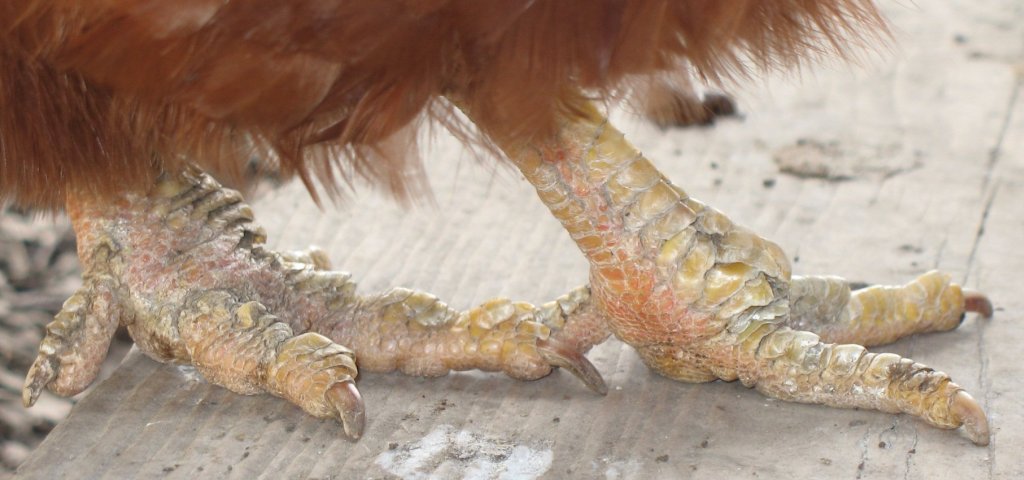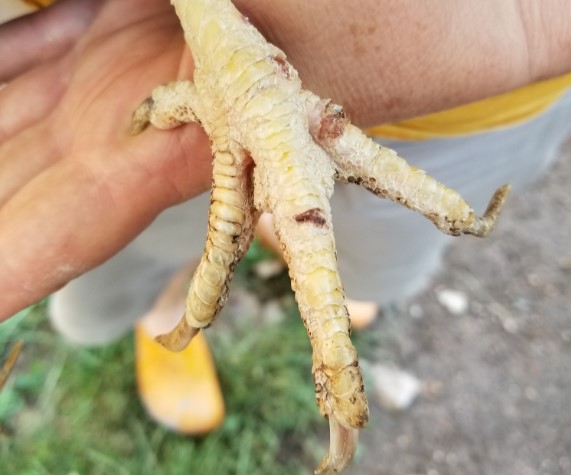
Scaly leg mites are nasty little creatures. These particular species of burrowing mites infest backyard and free-range chickens around the world. They usually burrow underneath the scales on chicken legs and feet, feed on their skin, and deposit poop in the space beneath. Over time, this causes the scales to lift from the skin and protrude outwards.
The worst thing about these little terrors is that they are microscopic. You won’t even know they are there until your flock begins to show signs of infestation.
Most bird owners believe that their chickens’ bumpy feet are normal. On the contrary, it’s a sign of trouble.
This article explores the early signs of scaly leg mites in birds and the treatment options available to eradicate these menacing parasites.
Signs of Scaly Leg Mites in Chickens
Chickens, like many other bird species, are prey animals. They often do their best to hide any signs of illness by putting up a brave front to make it appear like they’re healthy, even when they’re quite sick. Therefore, it is important to keep a close eye on them and pick them up frequently to examine them for anything out of the norm.
The earliest tell-tale sign of a scaly leg mite infection in chicken is flaking scales. A healthy chicken’s feet should be smooth, a lot like the belly of a snake. If you start to notice the scales flaking off their feet, you should seek treatment as soon as possible.
As the condition worsens, severe scaly leg mites cause your birds’ legs and feet to become so thick and crusted that it hinders mobility and may even cause part of their toes to start peeling off.
As is the case with all parasites, once one of the birds in your flock shows signs of infestation, the other birds will likely have it as well. Therefore, you will need to treat all of them to prevent the problem from getting out of hand.
Scaly leg mites may spur a bacterial infection, which may cause severe tissue inflammation. By this time, your bird will already have started exhibiting other sick bird symptoms like ruffled feathers with a puffed-up appearance and sitting down for extended periods.

Scaly Leg Mite Treatment
Treating scaly leg mites in chickens involves death by suffocation – of the mites, not the chicken. Here are the various options available.
Option 1: Using Oil and Vaseline
The first option involves soaking the chicken’s legs and feet in a tub of warm water. Hold the chicken in place for about 15 minutes to soften up the scales. Next, use a towel to dry the feet as you gently exfoliate any loose or dead scales.
In a different tub of oil – any kind of liquid oil will suffice – dip the chicken’s legs and feet in it and hold it in position for 15 minutes. The idea is for the oil to suffocate the mites.
Finally, wipe off the oil with a paper towel before slathering the legs and feet with Vaseline or any other petroleum jelly you might have. Ensure that you re-apply the jelly several times each week on the affected areas until the feet return to normal. This may take several months if the infestation was severe, so be patient.
Option 2: Using Sulfur and Vaseline
The other treatment option you can pursue is a combination of sulfur and Vaseline. Mix two tablespoons of sulfur powder with half a cup of petroleum jelly.
Apply a generous amount of the resulting paste to the affected area daily for two to three weeks. This method is also quite effective in suffocating the parasites and killing the nits (lice eggs).
Option 3: Using Ivermectin
Ivermectin for scaly leg mites is a highly potent treatment regimen recommended for severe cases of the condition. A veterinarian may prescribe oral or injectable forms of the drug to eradicate the parasite infestation in your flock.
They will generally administer a dose of 0.4mg of the Ivermectin per pound per bird once every ten days for two cycles. The drug can also be administered by applying it directly on the skin between their wings or at the base of the neck.
Since the withdrawal time of the drug is not known, it isn’t recommended for use on birds reared for eggs or meat.
Option 4: Using Gasoline and A&D Ointment
This is a quick and effective method for treating scaly leg mites. Here’s what you need to do.
Day 1
Start by placing the affected chicken legs and feet in a tub of gasoline. Don’t rub it on; just dip the legs in and hold the chicken in place for about five minutes. The gasoline suffocates the live mites and kills the nits.
Nits are often the biggest problem when trying to treat the condition. Other treatment methods often take weeks to kill off mite eggs, which are what cause recurrent infestations. Gasoline speeds up the process tremendously.
Next, lift them out of the tub and allow the feet to air-dry. This should take about a minute. Slather a generous amount of A&D ointment. This keeps the scales soft and supple and kick-starts the healing process.
Day 2
Skip the gasoline and just slather more A&D ointment on the affected areas. Once again, remember to be generous with your application.
Day 3
Repeat the steps you took on Day 1 using both the gasoline dip and A&D ointment. Your chicken’s legs and feet will be good as new in a few weeks.
Prevention of Scaly Leg Mites in Birds
Once you’ve treated all your birds, you’ll need to clean and disinfect the chicken coup thoroughly to prevent reinfection. Change the beddings and spray an insecticide to kill off any stray mites and nits that may be present.
Repeat this process every week until the problem is fully eradicated, and your birds no longer exhibit any signs of infestation. Use our online Vet Chat to consult with any of our qualified avian veterinarians today.




